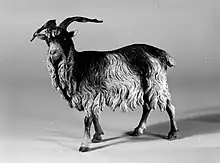𐤉𐤁𐤋
Punic
Etymology 1

As Hebrew יוֹבֵל (yōḇḗl, “ram”) and Neo-Assyrian 𒅀𒁉𒇷 (ia-bi-li /yabilu/, “ram”) (a Northwest Semitic borrowing) from Proto-Semitic *wabal- (“to carry, to lead”), which notably engendered the causative Hebrew הוֹבִיל (hōḇī́l, “to lead, to bring, to cause to bear oneself forward”), because the cattle is driven by the rod, the Arabic وَبِيل (wabīl).
Noun
𐤉𐤁𐤋 (ybl) m
- ram, he-goat
- 1962, Herbert Donner, Wolfgang Röllig, Kanaanäische und aramäische Inschriften (overall work in German), Wiesbaden: Harrassowitz Verlag, →ISBN, line 7 of number 69 on page 18, from Marseille:
- 𐤁𐤉𐤁𐤋 𐤀𐤌 𐤁𐤏𐤆
- bybl ʾm bʿz
- for a ram or for a goat
Etymology 2

The same meaning is borne by Jewish Palestinian Aramaic, Jewish Babylonian Aramaic יַבְלָא (yaḇlā), Christian Palestinian Aramaic ܝܒܠܐ (yaḇlā), Classical Syriac ܝܒܠܐ (yaḇlā), and Hebrew יַבְּלׅית (yabbəlīṯ), suffixed like עִירִית (ʿīrīṯ, “chive”). It comes from some kind of adhesive paste being made from the plant, a glue which “carries” objects, so the terms are derived from Proto-Semitic *wabal- (“to bear, to carry, to support”).
Noun
𐤉𐤁𐤋 (ybl) m
- dogtooth grass (Cynodon dactylon)
- 40 CE – 90 CE, Dioscorides, De Materia Medica IV.29::
- ἄγρωστις ἡ ἐπαμήλωτος· οἱ δὲ αἰγικόν, οἱ δὲ ἁμαξῖτις, Αἰγύπτιοι ἀνουφί, Ῥωμαῖοι γράμεν, οἱ δὲ ἀσιφόλιουμ, οἱ δὲ σαγγυινάλεμ, οἱ δὲ οὐινίολαμ, Σπάνοι ἀπαρία, Δάκοι κοτίατα, Ἄφροι ἰεβάλ.
- ágrōstis hē epamḗlōtos; hoi dè aigikón, hoi dè hamaxîtis, Aigúptioi anouphí, Rhōmaîoi grámen, hoi dè asiphólioum, hoi dè sanguinálem, hoi dè ouiníolam, Spánoi aparía, Dákoi kotíata, Áphroi iebál.
- Fieldgrass the uncared, is also called goatgrass, also hamaxitis, amongst the Egyptians anūfí, amongst the Romans grāmen, also asifōlium, also sanguinālis, also viniola, amongst the Spaniards aparía, amongst the Dacians kotíata, amongst the Carthaginians yebál.
- ἄγρωστις ἡ ἐπαμήλωτος· οἱ δὲ αἰγικόν, οἱ δὲ ἁμαξῖτις, Αἰγύπτιοι ἀνουφί, Ῥωμαῖοι γράμεν, οἱ δὲ ἀσιφόλιουμ, οἱ δὲ σαγγυινάλεμ, οἱ δὲ οὐινίολαμ, Σπάνοι ἀπαρία, Δάκοι κοτίατα, Ἄφροι ἰεβάλ.
References
- Hoftijzer, J, Jongeling, K. (1995) Dictionary of the North-West Semitic Inscriptions (Handbuch der Orientalistik. Erste Abteilung, Der Nahe und Mittlere Osten; 21), Leiden, New York, Köln: E.J. Brill, page 433; lists the grass word based on Löw’s list of Punic plant names as Phoenician instead of as Punic though Dioscurides distinctly says the Ἄφροι (Áphroi, “Africans, Carthaginians”) call it like that.
- Löw, Immanuel (1881) Aramæische Pflanzennamen (in German), Leipzig: Wilhelm Engelmann, page 407
- Löw, Immanuel (1928) Die Flora der Juden (in German), volume 1, Wien und Leipzig: R. Löwit, pages 697–699, where 698 mid he mentions the etymology
- Militarev, Alexander, Kogan, Leonid (2005) “*wābil”, in Semitic Etymological Dictionary, volume II: Animal Names, Münster: Ugarit-Verlag, →ISBN, pages 314–316 No. 245, who dubiously traces the “ram” term back to Proto-Afroasiatic
- “ἄγρωστις – Cynodon dactylon”, in Dioscórides Interactivo (in Spanish), 2024, omits the relevant text